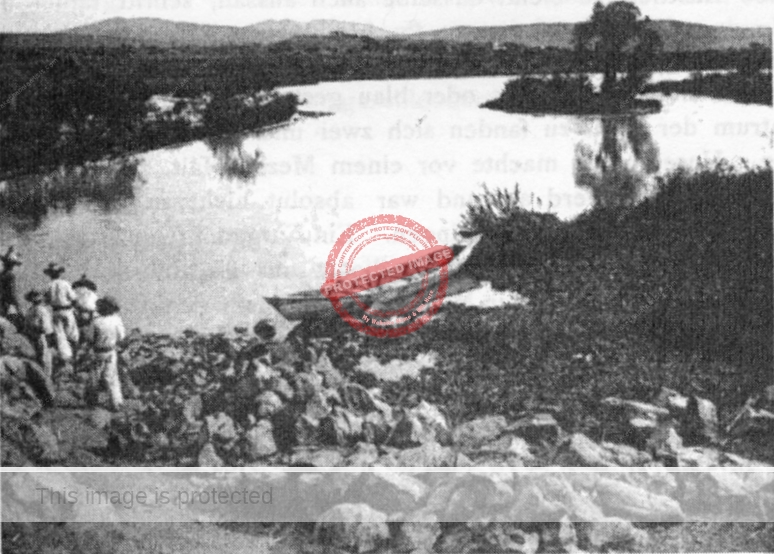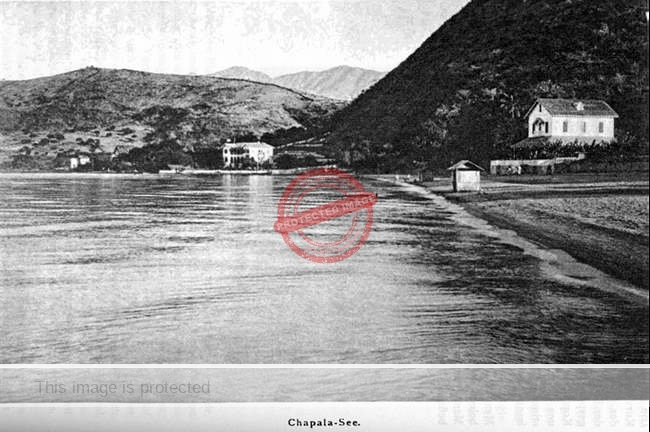Dr Wilhelm Schiess (1869-1929) visited Chapala briefly in 1899, during a winter trip to Mexico with his brother, Ernst. His detailed account of their trip, with dozens of photographs, was published in 1902 as Quer durch Mexiko vom Atlantischen zum Stillen Ocean (“Across Mexico from the Atlantic to the Pacific Ocean”). It was well received at the time as an accurate, first-hand account of several little-known parts of Mexico. Sadly—and presumably because the book was never translated—Schiess’s work has received relatively little attention.
Carl Wilhelm Schiess was born in Basel, Switzerland, on 12 July 1869 to Prof. Dr. Heinrich Schiess, a well-known ophthalmologist in that city, and his wife, Rosalie Gemuseus.
Schiess had already completed his medical training before visiting the US and Mexico with his brother in 1899. The two young men entered Mexico via New Orleans, before traveling by rail to Torreón and Durango, and crossing the Western Sierra Madre to Mazatlán. From there, they took a steamer to San Blas, and then proceeded to cross the country from west to east, via Tepic, Tequila, Guadalajara, Chapala, Zamora, Uruapan, Pátzcuaro, Morelia, Mexico City and Amecameca to Veracruz, before returning north via Orizaba, Cordoba, Guanajuato, Aguascalientes and Zacatecas. Quite the itinerary to complete in just two months!
The Schiess brothers had lots of adventures along the way. Like many other early travelers in Mexico, they even climbed to the summit of Popocatepetl Volcano, and photographed the interior of its crater. They visited remote mines and explored archeological sites, including Xochicalco.
The brothers arrived in Guadalajara on Monday 4 December 1899. The following morning, they left the city to view Juanacatlán Falls. They were very impressed by their grandeur, and the book includes photographs of the falls themselves, of a group of women washing clothes below the falls, and this photo of a then pristine River Santiago (aka Río Grande), immediately above the falls. After a full day exploring, they returned to their hotel in Guadalajara.

Wilhelm Schiess. 1899. Río Grande at Juanacatlán. (opp. p. 137)
The next day (Wednesday 6 December) they left the city by train en route to Chapala:
We set off at 10:20. Since our journey would not be long, we sat in second class. By 11.30am, we arrived in Atequiza, where the temperature was only 12°C. Back home, with such a cloudy sky, one would surely predict rain soon. However, no one here believed in rain at this time of year; instead, they assured us that the sun would soon shine again.
“Behind the train station, an eight-horse stagecoach was already waiting, along with a half-open carriage drawn by five mules. We took our seats in the carriage, which we had entirely to ourselves. We galloped off, and although this road seemed smooth compared to those we had previously encountered, we were still jolted and shaken considerably and had to hold on tightly to avoid being thrown from the carriage. As we sped along, one of the postillions frequently jumped down from the coach, ran as fast as he could alongside the carriage, and urged the mules to an even faster pace with his whip and shouts. The second driver swung his endlessly long whip from the coach seat.
“We raced along, always closely following the mail cart, passing over the rough cobblestones of Atequiza. The road led up and down hills, with little vegetation in sight—only a few bare trees with white blossoms here and there. An hour before reaching Chapala, we occasionally caught glimpses of the lake far below us. At a furious pace, we raced down the hill, and the two white church towers of Chapala approached with a completely different speed than the towers of Guadalajara had a few days ago. That time, we sat on exhausted animals, whereas today, five lively mules were pulling us along. At 1.30pm, we arrived in Chapala and stopped in front of the large, comfortably furnished hotel.”
The hotel was the Hotel Arzapalo, where:
In the spacious, European-style dining hall on the ground floor, we enjoyed our lunch and, from our table, had a magnificent view of the lake through the small orange garden in front of the hotel. The hotel is located directly on the shore. A bottle of red wine gave us the courage to ponder further adventures. Besides us, only a small family had taken a seat in the otherwise empty hall, giving the place a rather deserted appearance. The season had long since ended. In summer, many families, mainly from Guadalajara, come here to spend their time rowing and swimming. The sandy beach is perfect for children. The Chapala Lake is said to have a very mild climate, yet we happened to arrive on one of the least pleasant days imaginable. Now, people are even complaining about the cold!”

Wilhelm Schiess. 1899. Chapala. (opp. p. 153) The distant building on the left of the image is Villa Montecarlo, built by Septimus Crowe. In the middle is Villa Tlalocan, completed in 1896. The white residence on the right is Casa Capetillo.
Chapala itself is a small village, whose main street, consisting of closely built small houses, runs westward from the hotel, going up and down the hills along the lake. It is separated from the lake by beautiful gardens, where magnificent specimens of evergreen trees, blooming oleanders, blue morning glories, and red geraniums can be found. Small side alleys lead from the main street down to the lake. Along the lakefront, as well as partially in the water, there are trees through which one has a lovely view of the four or five stately villas of the village.
“Next to the hotel is the steamboat landing, which extends into the lake. It is planted with young trees and furnished with well-maintained benches for visitors. There is no daily regular steamboat service, even in summer. Behind the hotel rises a brown, barren hill that stretches westward along the lake. Along the village street, near the small water ponds, we noticed some women washing and bathing, who covered themselves upon our approach. The villas, with their terraces, offered a rather charming view from the lake, and in fine weather, living here must certainly be pleasant. East of the hotel, near the lake, stands the large white church, which presents a picturesque sight. Now and then, the sun shimmered through the dense clouds, bringing a bit of life to the otherwise deserted village. On the southern side of the lake, as well as in the west, high mountains could be seen everywhere. The lake has a somewhat dark and wild appearance—at least under this lighting—yet one still sees orange and banana trees. At 2.30pm, the temperature was 19°C, while the water measured 18°C. However, today we had no desire to go for a swim.”
After considering their options, the brothers decided not to stay overnight in Chapala, but to take a boat that afternoon to Ocotlán:
We could have stayed overnight in Chapala and taken the stagecoach back tomorrow. The steamboat arrives in Chapala only very irregularly and is mainly intended for transporting goods from the ranchos on the southern shore, so we could not rely on it. The only way to continue directly was to hire a sailing boat. Ernst therefore negotiated with two boatmen who agreed to take us to Ocotlán for 8 pesos.”
We examine their boat ride to Ocotlán, which turned out to be far more of an adventure than they had expected, in this post:
Links to a Swiss castle
Carl Wilhelm Scheiss is the unexpected link between Chapala and a famous Swiss castle. In 1900, shortly after his return to Switzerland, his aunt, Mrs. Rosina Magdalena Gemuseus, purchased Spiez Castle on Lake Thun in the Swiss canton of Bern, and invited Scheiss and his wife, Helene Schiess-Frey (1882–1962), to live there. In July 1900, Schiess opened a medical practice based in the castle, parts of which date back to the tenth century. He lived in the castle for several years, with office hours every morning to 11.00am, and clinics for eye diseases every Tuesday and Friday morning.
The village of Spiez grew rapidly: roads were improved and villagers added a new stone church and many new homes. In about 1906, close to the time his son was born, Schiess commissioned a firm of Basel architects to build him a large family home in the village, with an attached medical office.
In 1907, Schiess’s aunt sold him some of the outlying castle properties, including the old church, rectory, manager’s house, cherry orchard, vineyards and an area of forest. Schiess continued to live quite modestly, accustomed to making home visits to patients by bicycle. Contemporaries described him as a friendly, helpful and keen doctor, who worked tirelessly without any break during the terrible 1918 flu epidemic.
Following the death of his aunt on 3 February 1919, Schiess inherited the castle itself. But the upkeep was costly, and Schiess soon found himself having to sell valuables from the castle to cover ongoing maintenance expenses. By 1922 he started looking for a potential purchaser. In the absence of finding anyone, a group of villagers established a foundation five years later with the idea of preserving the castle for future generations. On 14 August 1929, barely two weeks after the Spiez Castle Foundation took over the castle, Schiess died unexpectedly of heart failure.
The castle and gardens opened to the public in June 1930 and are now used for conferences, concerts, exhibitions and other events. Curiously, it is apparently not known which precise rooms of the castle were once used by the doctor and his wife.
Note: Translations of Schiess’ text are by the author and were AI-assisted.
Sources
- Tony Burton. 2016. “A 1902 travel account, and unexpected link between Mexico and a Swiss castle.” Post dated 25 February 2016 on Geo-Mexico.com.
- Wilhelm Schiess. 1902. Quer durch Mexiko vom Atlantischen zum Stillen Ocean. Berlin: Dietrich Reimer.
- Alfred Stettler. 2004. “75 Jahre Stiftung Schloss Spiez: Die Anfänge” in Jahrbuch: vom Thuner und Brienzersee, Uferschutzverband Thuner- und Brienzersee.
Comments, corrections and additional material are welcome, whether via the comments feature or email.
Tony Burton’s books include “Lake Chapala: A Postcard History” (2022), “Foreign Footprints in Ajijic” (2022), “If Walls Could Talk: Chapala’s historic buildings and their former occupants” (2020), (available in translation as “Si Las Paredes Hablaran”), “Mexican Kaleidoscope” (2016), and “Lake Chapala Through the Ages” (2008).
Thanks—don’t know why but I like but both photos of lake strike me as different than most lake photos. I can’t put my finger on why they seem different.
Bill, The first photo is not actually of the lake. It was taken some miles downstream on the R. Santiago, just before the Juanacatlan Falls. Best, Tony.